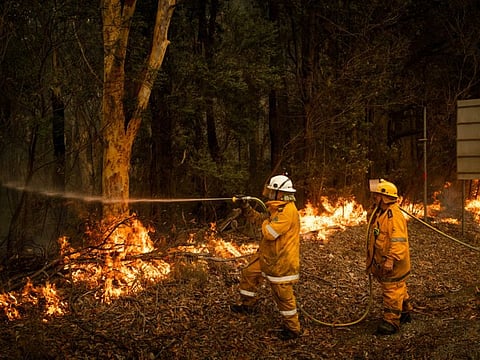Newsmaker: Australia’s firefighters — The flame-licked heroes
70,000 firefighters are trying to save homes, schools, shops, communities and a country

The entire UAE measures 8.36 million hectares. By Tuesday, bush fires in Australia had destroyed more than 8.4 million hectares of New South Wales and Victoria — and there will be little if any break in the weather anytime soon.
The University of Sydney estimates that more than 480 million animals have been killed in this current spate of bush fires. That figure includes reptiles, mammals and birds directly from the fires, or from loss of habitat, food and water. And that’s just the figure for New South Wales alone. Add in Victoria and it’s far greater.
Satellite imagery from Nasa’s Earth Observatory shows plumes of smoke from Australia telling as far as South America — and at the current rate of burning, the smoke with circumnavigate the southern hemisphere itself, just adding to the nightmarish scenario being played out there.
It is all-out war for these flame-licked heroes who face a rapidly changing situation on the ground, with wind changes making separate fires united into dense walls of flame that suck oxygen from the air and jump from one patch of ground to the next without warningMick O'Reilly
The death toll is around 30. The financial toll is AU$5 billion (Dh12.6 billion) — and rising by the day. There’s no price on the emotional toll.
The physical toll? Well that’s been shouldered for the past three weeks non-stop by an estimated 70,000 firefighters up and down south east Australia. And this army of mostly volunteers is being augmented by the Australian military, its reserves and firefighters from other parts of the continent, New Zealand, the United States and Canada.
It is all-out war for these flame-licked heroes who face a rapidly changing situation on the ground, with wind changes making separate fires united into dense walls of flame that suck oxygen from the air and jump from one patch of ground to the next without warning. Months of drought make for tinder-dry conditions perfect for whirling firestorms that touch down with all of destructive power of tornadoes — except it’s flame-throwers igniting the parched grassy ground and bushes. Eucalyptus trees, so rich in medicinal oils and quick to grow, spontaneously combust and burn with the intensity of a grease and wood fore combined — throwing off sparks that set other blazes.
For the firefighters, this is as bad as it gets.
The ultimate inferno
Take Daniel Knox, a 22-year-old who normally works as a landscape gardener in southwest Sydney. Five years ago, he volunteered to fight fires with Horsley Park Fire Brigade. He has been fighting fires non-stop since the middle of December, 15 hours at a time in firefighting equipment in conditions that exceeds 50 degrees Celsius on good days — if there is indeed ever a good day to fight a wall of fires, lay down kilometres of hoses, cut trees and try to build fire breaks that the flames won’t leap.
Knox is part of the New South Wales Rural Fire Service (NWS RFS) — the world’s largest volunteer firefighting service with 70,000 members. “We’re doing it because it’s a passion,” he told the BBC. “It’s a brotherhood.”
The model goes back more than a century, is common in Victoria, NSW and Western Australia — states that traditionally battled bush fires in the summer. Now, such fires are common in Tasmania and even sub-tropical Queensland — another indicator is one is needed of global warming at work.
Earlier this week, the federal government announced compensation for the volunteers of AU$300 per day, topping out at AU$6,000 to augment income those volunteers lost from their normal lines of work.
Everyday battle
But these everyday heroes who battle these worsening bushfires also face a crisis within their own ranks. Rural populations are dwindling, fewer are willing to spend the time training and volunteering, and in Victoria alone, a state that on paper supposed to be able to call on some 35,000 volunteers, one position in seven is vacant. In NSW, it’s a similar story of depleted ranks.
If there is one silver lining, the sheer scale of this current disaster has led to a surge in volunteers signing up for the rural fire services. That’s all well and good — the current fires have to be put out before any of the fire services can think of training those new members.
Australian media also report that one of the reasons for fewer men on the fire lines now is that there has been a rivalry between the rural volunteer fire services and the larger, city-based full-time fire departments. While the city elements are playing their part in areas close to the cities where fires break out, the worst of the crisis in rural communities and towns where volunteer fire services work.
The flames, however, don’t make any distinction now between volunteers or full-timers — and neither do the men and women manning the fire hoses, cutting down trees, clearing bush, setting controlled burns to stave the big blazes and putting their lives on the line to save their homes and schools, shops and lives of their neighbours.
Also Read: Australian bushfires a glimpse of our future
Sign up for the Daily Briefing
Get the latest news and updates straight to your inbox


